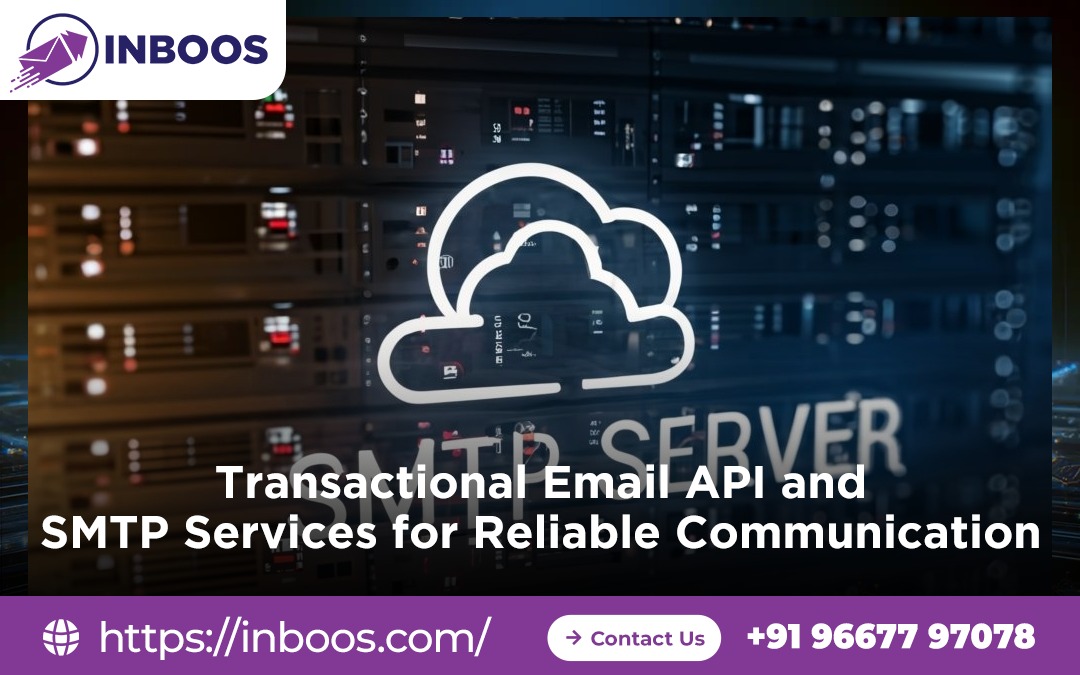For any startup, email isn’t just a communication channel; it’s the lifeline to your users and customers. From sending crucial welcome emails and password resets to dispatching product updates and marketing campaigns, reliable email delivery is non-negotiable. Yet, many startups mistakenly rely on basic email accounts or neglect proper setup, leading to lost messages, damaged reputation, and missed opportunities.
The truth is, effective email communication at scale requires a professional SMTP server setup. SMTP (Simple Mail Transfer Protocol) is the industry standard for sending email, and choosing the right service and configuring it correctly is foundational for your startup’s success.
This in-depth guide will demystify SMTP setup, explaining why it’s crucial for your growing business and walking you through everything you need to get started the right way.
What is an SMTP Server and Why Startups Need One
At its core, an SMTP server acts as your email’s dedicated post office. When your application sends an email, it hands it off to an SMTP server, which then takes on the complex task of routing that message through the internet to the recipient’s inbox.
While you might use an email client like Gmail or Outlook for personal correspondence, they are not designed for the volume and reliability required by a startup. This is why a dedicated SMTP service is absolutely crucial:
- Deliverability: Professional SMTP services are built to ensure your emails bypass spam filters and reach the inbox. They manage IP reputation, handle complex authentication, and adapt to ISP policies, which are nearly impossible for a single startup to do on its own.
- Scalability: As your user base grows, so does your email volume. A dedicated SMTP service can handle thousands, even millions, of emails per day, scaling seamlessly with your needs without crashing your systems or getting your account blocked.
- Reliability: For critical transactional emails (like password resets or order confirmations), failure is not an option. SMTP services offer robust infrastructure and monitoring, ensuring these vital messages are always delivered.
- Analytics & Insights: Gain valuable data on open rates, click-through rates, bounces, and spam complaints. These insights are essential for optimizing your campaigns and improving user engagement.
- Automation & Integration: Easily connect with your existing applications, CRM systems, and marketing automation platforms via APIs or simple SMTP configurations, streamlining your workflows.
Choosing the Right SMTP Service for Your Startup
Selecting an SMTP service provider is a critical decision. Not all services are created equal, and the “best” one depends on your specific needs, volume, and budget.
Broadly, SMTP services can be categorized as follows:
| Service Type | Primary Focus | Ideal For Startups? | Considerations |
| Transactional Email Service | High deliverability for automated, critical emails | Highly Recommended | Optimized for speed, reliability, and deliverability. Often API-first. |
| Marketing-Focused ESPs | Campaign management, newsletters, automation sequences | Good for combined marketing/transactional if features align | May have stricter transactional limits or less granular deliverability controls. |
| Self-Hosted SMTP Servers | Full control, advanced customization | Not Recommended | High technical overhead, significant deliverability challenges, costly. |
Table 1: SMTP Service Evaluation Checklist for Startups
| Feature/Consideration | Why It Matters for a Startup |
| Deliverability Rate | Most important. Directly impacts whether your emails reach users. Look for high inbox rates. |
| Pricing & Scalability | Start with a free tier/low cost, scale affordably as you grow. Understand pricing tiers. |
| Ease of Integration | Good API documentation, SDKs for common languages, clear SMTP connection details. |
| Analytics & Reporting | Dashboards for opens, clicks, bounces, complaints. Essential for optimizing. |
| Customer Support | Responsive support (chat, email) for technical issues. Your time is valuable. |
| Security & Compliance | GDPR, CCPA, CAN-SPAM compliance. Data privacy is paramount. |
| Reputation Management | How they manage shared/dedicated IPs, blacklisting, and feedback loops. |
| Webhooks | Real-time notifications for delivery status, bounces, and unsubscribes. |
Step-by-Step SMTP Server Setup for Your Domain
Once you’ve chosen your provider, the setup process involves a few crucial steps to configure your domain and integrate it with your application.
Step 1: Sign Up with an SMTP Service Provider
- Visit the website of your chosen provider (e.g., SendGrid, Mailgun, Postmark, AWS SES, Resend).
- Follow their signup process. Many offer a generous free tier or trial period, which is perfect for startups to test the waters.
Step 2: Authenticate Your Sending Domain (The Big Three: SPF, DKIM, DMARC)
This is the most critical step for deliverability. It tells receiving email servers that your emails are legitimate and authorized. Your chosen SMTP provider will give you specific records to add to your domain’s DNS settings.
- SPF (Sender Policy Framework): A DNS record (
TXTtype) that lists which servers are authorized to send email on behalf of your domain. It helps prevent spammers from spoofing your “From” address. - DKIM (DomainKeys Identified Mail): Also a
TXT(orCNAME) DNS record. It adds a digital signature to your emails, allowing recipients’ servers to verify that the message hasn’t been tampered with and truly originated from your domain. - DMARC (Domain-based Message Authentication, Reporting & Conformance): This
TXTrecord defines your policy for emails that fail SPF or DKIM checks (e.g., quarantine, reject) and provides you with valuable reports on authentication failures.
Your Action:
- Log into your domain registrar (e.g., GoDaddy, Namecheap, Cloudflare).
- Navigate to your domain’s DNS management settings.
- Add the
TXT(and possiblyCNAME) records exactly as provided by your SMTP service. - Allow up to 24-48 hours for DNS changes to propagate globally, though often it’s much faster.
Step 3: Choose Your Sending Domain/Subdomain Strategy
For startups, it’s highly recommended to use a dedicated subdomain for your transactional and marketing emails (e.g., mail.yourdomain.com or mg.yourdomain.com).
Why a Subdomain?
- Reputation Isolation: If a campaign or email type (e.g., cold outreach) accidentally hits a spam trap or receives too many complaints, it protects the reputation of your main domain (
yourdomain.com), which is vital for your website and core business communications. - Clearer Tracking: Easier to organize and track emails originating from specific purposes.
Your Action: Decide on a subdomain (e.g., emails.yourcompany.com) and configure your ESP to send from it. Your SPF, DKIM, and DMARC records will then be set up for this specific subdomain.
Step 4: Get Your SMTP Credentials or API Key
Your SMTP service will provide the necessary details to connect your application:
- SMTP Credentials:
- Host: The server address (e.g.,
smtp.sendgrid.net). - Port: The port number (commonly
587with TLS, or465with SSL). - Username: Often an API key or a specific username provided by the service.
- Password: Often an API key or a password specific to your SMTP user.
- Host: The server address (e.g.,
- API Key: Many modern services prefer API integration, where you get a long, unique string (API key) to authenticate requests. This is generally more secure and flexible.
Your Action: Locate these credentials or API keys in your SMTP provider’s dashboard and keep them secure (use environment variables, not hardcoded in your public code).
Step 5: Integrate with Your Application/Website
This is where your code or platform connects to the SMTP service.
- Via SMTP Connection (Traditional): Most programming languages (Python, Node.js, PHP, Ruby, Java) have built-in libraries for SMTP.Python
# Pseudo-code example (Python) import smtplib from email.mime.text import MIMEText msg = MIMEText('This is your email content.') msg['Subject'] = 'Your Startup Email' msg['From'] = 'noreply@yourdomain.com' msg['To'] = 'user@example.com' try: with smtplib.SMTP('smtp.yourprovider.com', 587) as server: server.starttls() server.login('your_username', 'your_password') server.send_message(msg) print("Email sent successfully!") except Exception as e: print(f"Error sending email: {e}") - Via API Integration (Recommended): For more robust applications, use the provider’s official SDKs. This is generally simpler, more secure, and offers better error handling and feature access.Python
// Pseudo-code example (Node.js using a hypothetical SDK) const client = require('your_provider_sdk')('YOUR_API_KEY'); async function sendEmail() { try { const response = await client.send({ to: 'user@example.com', from: 'noreply@yourdomain.com', subject: 'Your Startup Email', html: '<p>This is your email content.</p>' }); console.log('Email sent:', response); } catch (error) { console.error('Error sending email:', error); } } sendEmail(); - CMS/Platform Plugins: If you use platforms like WordPress, Shopify, or others, there are often specific plugins or built-in settings to configure SMTP. Search their plugin marketplaces or documentation.
Your Action: Refer to your SMTP provider’s API documentation and your application’s framework/CMS documentation for exact integration steps.
Step 6: Warm Up Your Sending Domain (Crucial for New Senders)
This step cannot be skipped, especially for new domains or if you plan to send significant volume. Email warm-up is the process of gradually increasing your email sending volume from a new domain/IP to build a positive sender reputation with ISPs.
- Start Small: Begin by sending a very small volume (e.g., 50-100 emails/day) to highly engaged recipients.
- Gradually Increase: Slowly increase your daily sending volume over several weeks, following a consistent schedule provided by your ESP or a warm-up tool.
- Monitor Engagement: Focus on getting opens, clicks, and replies during warm-up. These positive interactions signal to ISPs that your emails are valued.
Your Action: Implement a diligent warm-up strategy. Patience here is an investment in long-term deliverability.
Essential Features and Best Practices for Startups
Beyond the initial setup, leverage your SMTP service’s features and follow these best practices:
- Deliverability Monitoring: Use your ESP’s dashboard or third-party tools to track inbox placement, bounce rates, and spam complaints.
- Detailed Analytics: Regularly review open rates, click-through rates, and conversion metrics to optimize your email content and strategy.
- Template Management: Utilize your ESP’s templating system for reusable, responsive email designs.
- Webhooks: Set up webhooks to receive real-time notifications about email events (delivery failures, opens, clicks) directly in your application. This enables instant list hygiene and user activity tracking.
- Suppression Lists: Ensure your ESP automatically handles unsubscribes and hard bounces by adding them to suppression lists. This protects your reputation.
- List Hygiene: Regularly clean your email lists to remove invalid or unengaged contacts, especially for marketing campaigns.
- Segmentation: Divide your audience into smaller, targeted groups to send more relevant and personalized emails, which boosts engagement and deliverability.
- Mobile Responsiveness: Always design and test your emails to ensure they look great and function well on all mobile devices.
Common Pitfalls to Avoid
Setting up your SMTP server can seem complex, but avoiding these common mistakes will save you a lot of headaches:
Table 2: Common SMTP Setup Mistakes & Fixes for Startups
| Mistake | Consequence | How to Fix It |
| Not Authenticating Your Domain | Emails go to spam/rejected, poor reputation. | Implement SPF, DKIM, and DMARC for your sending domain/subdomain. Verify them using online tools. |
| Ignoring Email Warm-Up | Sudden high volume looks like spam, leads to blocking. | Gradually increase sending volume over weeks. Start small, send to engaged contacts first. |
| Sending to Unverified/Old Lists | High bounce rates, spam complaints, blacklisting. | Never buy lists. Use an email verification service. Regularly clean inactive subscribers and hard bounces. |
| Not Handling Bounces/Unsubscribes | Continued sending to invalid/unwilling users harms reputation. | Utilize your ESP’s automatic suppression lists. Respond to webhooks for real-time bounce/unsubscribe updates in your CRM/database. |
| Using Personal Email for Mass Sends | Rate limits, account suspension, poor deliverability. | Always use a professional SMTP service for transactional and marketing emails. |
| Ignoring Analytics/Error Logs | You won’t know if emails are failing or if strategy is ineffective. | Regularly check your ESP’s dashboards. Monitor open/click rates, bounce rates, and spam complaints. Review API response logs for errors. |
Conclusion
For startups, a properly configured SMTP server is not just a technical detail; it’s a strategic asset. By investing the time to set up your domain with the right authentication, choosing a robust service, and following best practices for integration and warm-up, you lay a solid foundation for reliable email communication. This allows you to focus on what matters most: building your product and delighting your customers, knowing that your critical emails will always reach their destination.
📩 Have Questions or Need Expert Help?
Our team is here to make your email marketing, bulk emailing, and mass emailing effortless and effective.
🚀 Let’s boost your deliverability, scale your outreach, and unlock better results!
👉 📌 Contact Us Today
 logo
logo




